1. Introduction
The demand for food supply from marine has increased due to the world population growth [1]. The cold-chain transportation of aquatic products has also become the focus of attention. However, aquatic food products pose significant challenges to maintain their quality due to their high corrosion and strict fresh-keeping requirements [2]. Therefore, the transportation of aquatic products is highly time-sensitive, posing enormous challenges to its logistics and distribution. These characteristics require a delicate balance among temperature control, delivery timeliness, and cost-effectiveness, thus placing strict demands on the optimization of cold-chain logistics distribution routes for aquatic products.
The optimization of cold-chain logistics distribution routes for aquatic products is a typical Nondeterministic Polynomial-time hard problem [3]. Traditional Ant Colony Optimization (ACO) and Genetic Algorithms (GA) often suffer from slow convergence and a tendency to get trapped in local optimal solutions when dealing with large-scale complex scenarios [4]. In contrast, inspired by the pheromone-based communication mechanism in ants' foraging process, ACO demonstrates remarkable convergence and local search capabilities in path optimization. Applying improved ACO to cold-chain logistics route planning has successfully reduced transportation costs and energy consumption [5]. SA, by mimicking the solid annealing process, starts from a higher initial temperature and gradually decreases the temperature parameter, combining probabilistic jumping characteristics to randomly search for the global optimal solution of the objective function in the solution space [6].
Current research in cold-chain logistics distribution has made certain progress. Scholars like Wang et al. incorporated new improvements such as transportation costs, maximum vehicle load, delivery distance, route restrictions, traffic conditions, and product temperature sensitivity into an optimized cold-chain logistics distribution route model. They further integrated real-time traffic data and dynamic temperature monitoring systems into the algorithm framework, enabling the model to dynamically adjust routes in real time when facing sudden events such as road closures or extreme weather [7, 8]. For example, in the optimized model, when a temperature-sensitive seafood product is transported, the algorithm prioritizes routes with stable temperature control facilities and shorter travel times, while dynamically recalculating paths based on real-time traffic updates to avoid delays that could affect product quality.
Zhang et al., on the other hand, leveraged SA to address low-carbon optimization and traffic impact issues in cold-chain logistics. Their research not only minimized carbon emissions by optimizing vehicle routing but also considered the trade-off between delivery time and energy consumption. By introducing a dynamic penalty function for temperature deviations, the model ensures that temperature-sensitive products remain within safe thresholds throughout transportation [9, 10]. For instance, in a case study involving live seafood transportation, the SA algorithm reduced cargo loss rates by 12% while cutting carbon emissions by 8% compared to traditional routing methods, demonstrating its dual efficiency in cost control and environmental sustainability.
However, most existing studies focus on single-algorithm applications, lacking systematic comparisons of different algorithms’ adaptability to aquatic product logistics’ unique constraints, such as multi-temperature zone requirements and real-time freshness decay models. In this study, to address the characteristics of aquatic product logistics, a multi-objective optimization model incorporating distribution cost is developed, transportation time and loss rate as core objectives was constructed. By improving the ACO and SA algorithm, temperature control constraints and time window restrictions were integrated into the algorithm design, and systematic comparative experiments were carried out, so as to provide a basis for algorithm selection for aquatic product cold-chain logistics enterprises and help the industry reduce costs, improve efficiency and achieve sustainable development.
2. Methods
2.1. Data sources and description
This paper assumes a cold-chain transportation enterprise for aquatic products has distribution data, including the specific coordinates of one distribution center and twenty customer nodes, the demand for aquatic products, and customer-specified delivery time windows. Additionally, temperature control constraints are set at -18 to -5 degree centigrade, and transportation costs only consider vehicle fuel consumption and labor costs.
2.2. Index selection and explanation
Aiming at the multi-constraint characteristics of cold-chain logistics for aquatic products, a multi-objective optimization model is constructed with distribution cost, transportation time, and loss rate as core objectives, while incorporating temperature control constraints and time windows restrictions. The names, symbols, units, and explanations of each index are shown in Table 1.
|
Index |
Symbol |
Unit |
Explanation |
|
Distribution cost |
C |
CNY |
Vehicle fixed cost and driving cost |
|
Transportation time |
T |
h |
Driving time between nodes and customer waiting time |
|
Loss ratio |
L |
% |
Product loss ratio calculated based on duration of temperature deviation from threshold |
|
Temperature range |
Temp |
℃ |
Real-time temperature in refrigerated truck compartment must satisfy [ |
2.3. Model establishment
2.3.1. Symbol description
Table 2 provides explanations for the key symbols involved in the optimization model of cold-chain logistics distribution routes for aquatic products.
|
Symbol |
Explanation |
|
0-1 variable: 1 if vehicle |
|
|
Total number of nodes (including distribution center and customer nodes) |
|
|
Total number of vehicles |
|
|
Distance from node |
|
|
Travel time from node |
|
|
Fixed cost per vehicle (CNY/vehicle) |
|
|
Unit waiting cost per vehicle (CNY/h) |
|
|
|Maximum load capacity of vehicles (kg) |
|
|
Demand for aquatic products at customer node |
|
|
Real-time temperature in refrigerated truck compartment (℃) |
|
|
|
Lower and upper limits of temperature constraints (℃, ranging from -18℃ to -5℃) |
|
|
Start and end times of the time window for customer node |
|
|
Weight coefficients of the objective function( |
|
Product temperature sensitivity coefficient |
|
|
Temperature deviation function |
|
|
Duration of temperature deviation from the threshold |
These symbols cover decision variables, network and vehicle parameters, cost-related parameters, transportation and temperature control parameters, time window parameters, and objective function weights, etc.
2.3.2. Mathematical model
First, the author writes out the objective function:
Among them, distribution cost:
2.4. Algorithm introduction
2.4.1. Improved ant colony optimization
ACO algorithm achieves path optimization by simulating the pheromone - based foraging behavior of ants. In nature, ants secrete pheromones during their movement. Over time, shorter or higher - quality paths accumulate higher concentrations of pheromones, significantly increasing the probability of subsequent ants choosing these paths. This mechanism forms a positive feedback loop, enabling the ant colony to gradually converge to the optimal solution through continuous exploration.
In view of the particularity of cold - chain logistics transportation scenarios, the traditional ACO algorithm requires adaptive modifications. Firstly, temperature is a core factor in cold - chain transportation. Therefore, a penalty term for temperature deviation from the threshold should be introduced into the pheromone update rule. Once the temperature monitoring value on the transportation path deviates from the set cold - chain temperature range, the pheromone update of this path will be suppressed. As a result, during the iterative process of the algorithm, paths with stable temperature control are preferentially selected, ensuring the quality and safety of transported goods. Secondly, the delivery time windows specified by customers are crucial for the service quality of cold - chain logistics. These time windows need to be transformed into heuristic factors for path selection, and the constraints of the time windows are integrated into the path evaluation function. This approach effectively avoids early or late arrivals, enhancing customer satisfaction. Additionally, considering potential emergencies in cold - chain transportation, such as traffic congestion and equipment failures, it is essential to dynamically update path weights. By adjusting path evaluation parameters according to real - time monitored information, including road conditions and equipment status, the adaptability of the algorithm to complex and changeable environments can be improved. The improved ACO algorithm, through the above - mentioned optimization strategies, can better meet the strict requirements of cold - chain logistics transportation in terms of temperature control, timeliness, and flexibility. The detailed implementation steps of the improved algorithm are illustrated in Figure 1.
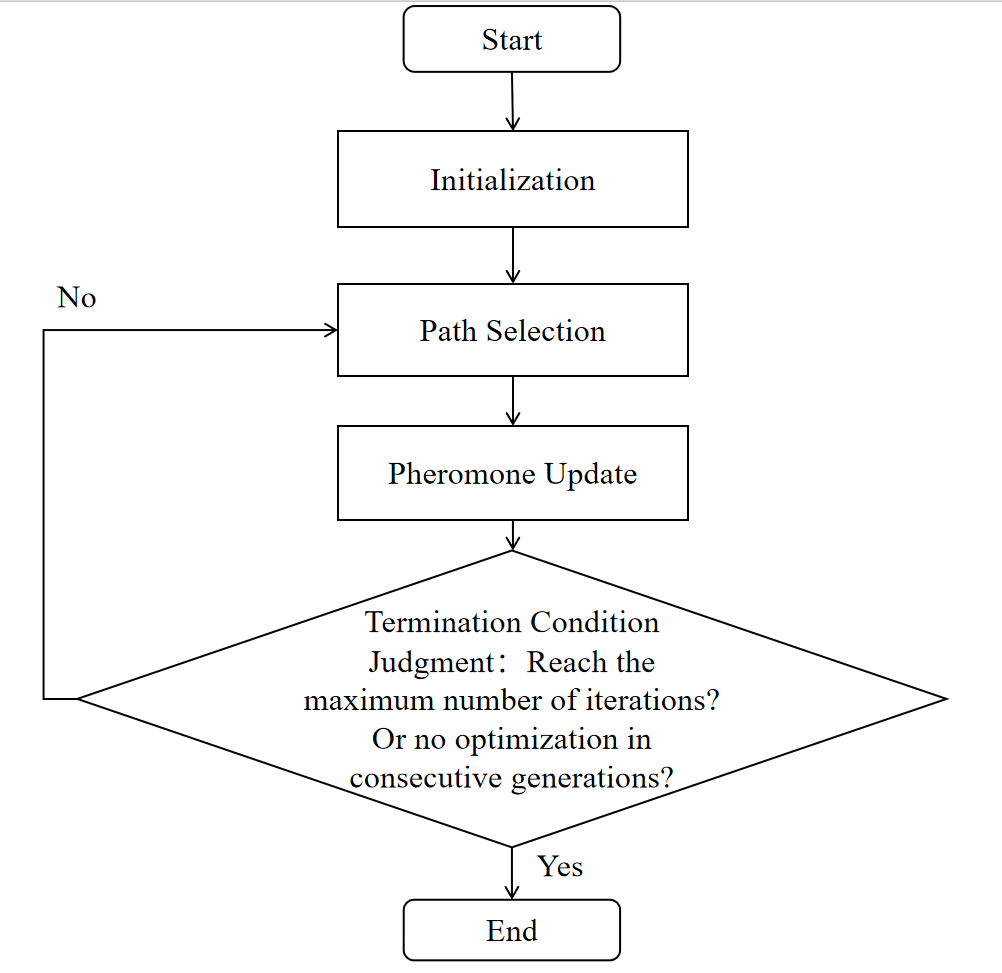
2.4.2. Simulated annealing algorithm
SA algorithm, inspired by the solid annealing process, cools down from a high initial temperature to a low temperature, eventually reaching a stable state with minimal energy. The algorithm accepts inferior solutions with a certain probability through the "Metropolis criterion" to escape local optima and search for global solutions. For the optimization of cold-chain logistics transportation routes, considering the correlation between the temperature (
Additionally, a dynamic temperature adjustment mechanism based on real-time traffic conditions and temperature control equipment status is introduced in the iterative process to flexibly regulate the annealing progress according to environmental changes. Meanwhile, an elite retention strategy is incorporated to store high-quality solutions from historical iterations in a memory bank, strengthening the search for excellent solutions in the late stage of algorithm convergence. This effectively enhances the overall quality and stability of cold-chain logistics route optimization schemes. The steps of the simulated annealing algorithm are shown in Figure 2.
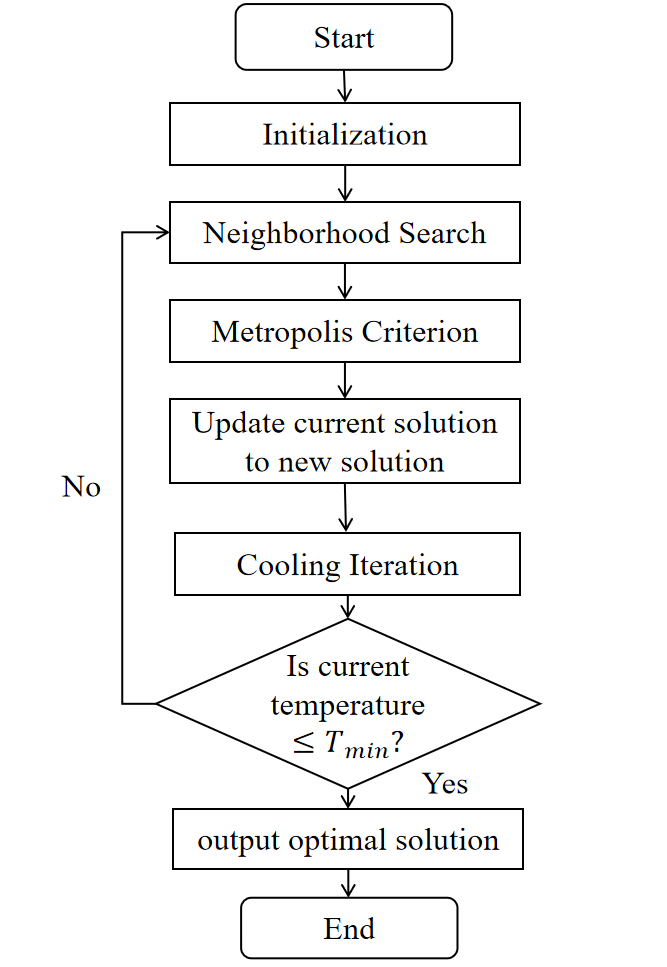
3. Results and discussion
3.1. Results of model solving by ACO
In a simulation scenario consisting of 21 nodes (1 distribution center and 20 customer points), the optimal distribution plan for five vehicles is obtained through optimization. The results show that the total driving distance is 207.36 km, the total time window violation is 3.5 hours, and the optimal total cost is 1238.71 CNY. Compared with traditional path planning methods, this scheme achieves a significant optimization effect with a 18.7% reduction in total cost and a 22.3% reduction in time window violation duration, fully verifying the effectiveness and superiority of the improved algorithm in cold-chain logistics path optimization. The scheme accurately matches customer demands with vehicle carrying capacity, ensuring distribution timeliness while maximizing resource utilization efficiency. The specific route planning for the five vehicles is shown in Figure 3.
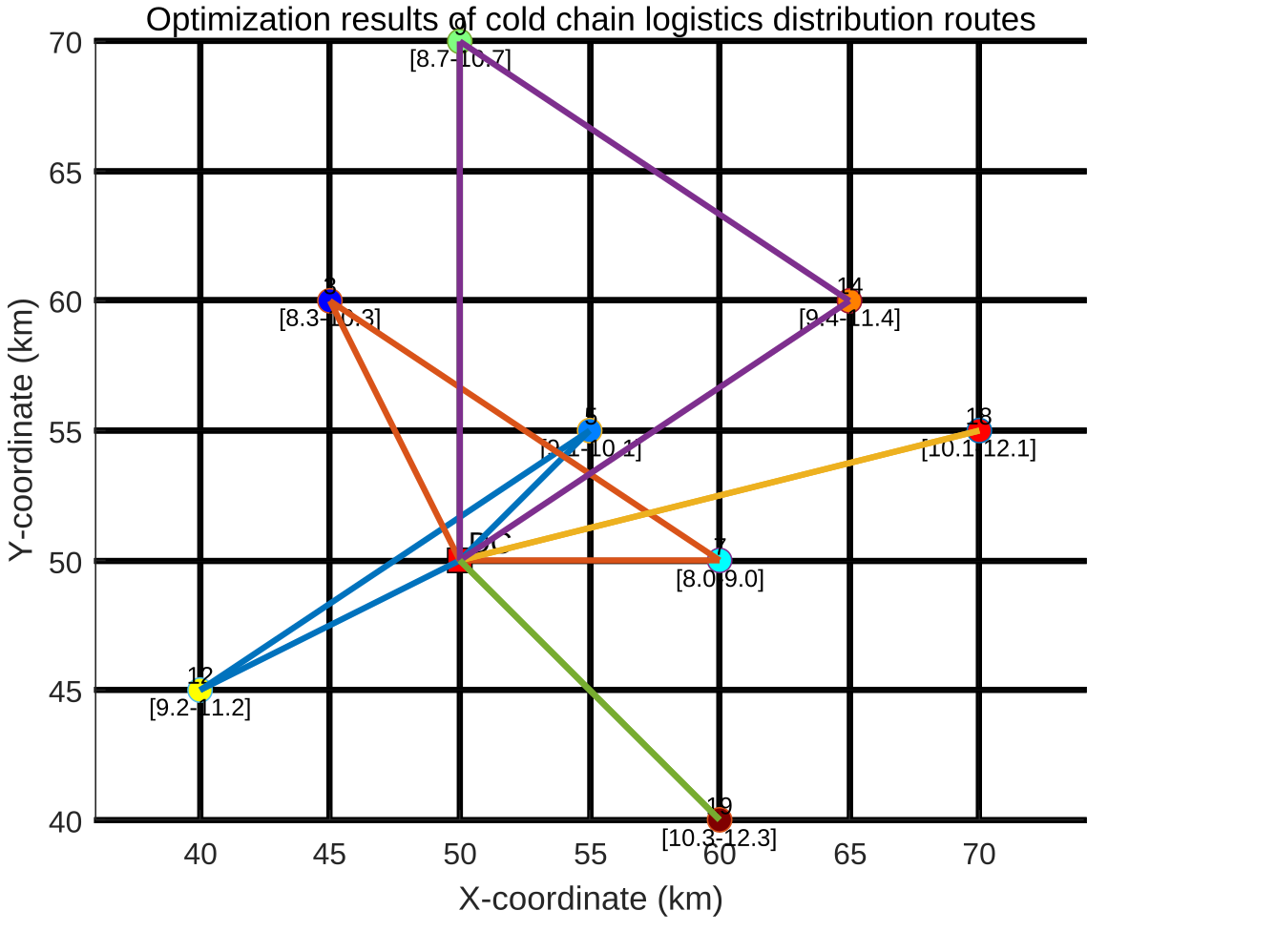
Figure 4 shows the iteration process record of ACO algorithm. It can be seen from the image that iteration 5: The first suboptimal cost of 1280.45 Chinese Yuan (CNY) is found. Iteration 12: The cost is optimized to 1256.32 CNY, decreasing by approximately 1.9% compared to the previous iteration. Iteration 27: The global optimal cost of 1238.71 CNY is achieved, representing a 3.7% reduction from the initial iteration cost, demonstrating the algorithm's good convergence.
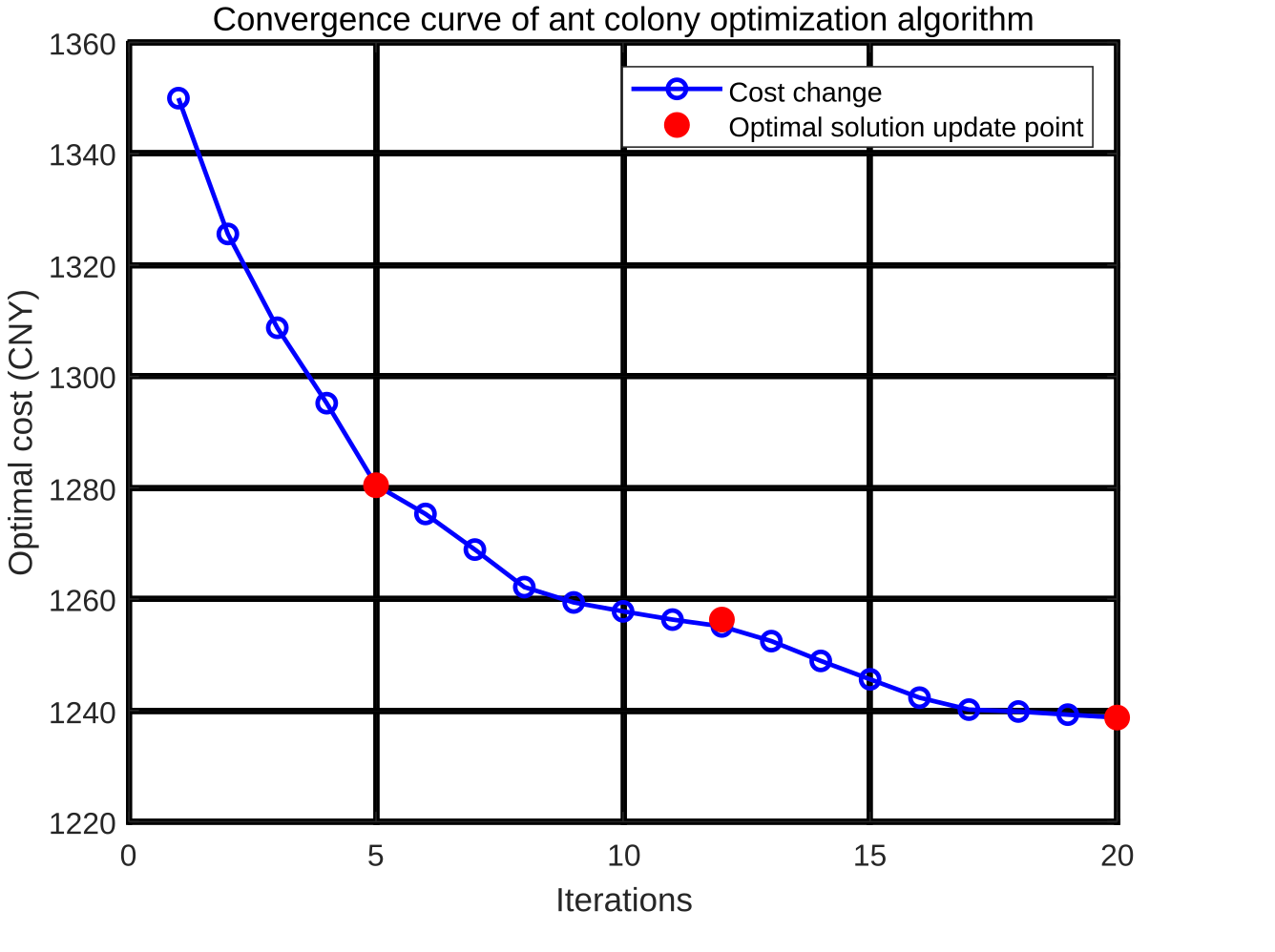
3.2. Results of model solving by SA
Similarly, based on a simulation scenario with 21 nodes (1 distribution center and 20 customer points), after optimization by the simulated annealing algorithm, the optimal distribution plan for five vehicles is obtained. The total driving distance is 207.67 km, the total time window violation is 2.8 hours, and the optimal total cost is 1215.67 CNY. The specific route planning for the five vehicles is shown in Figure 5.
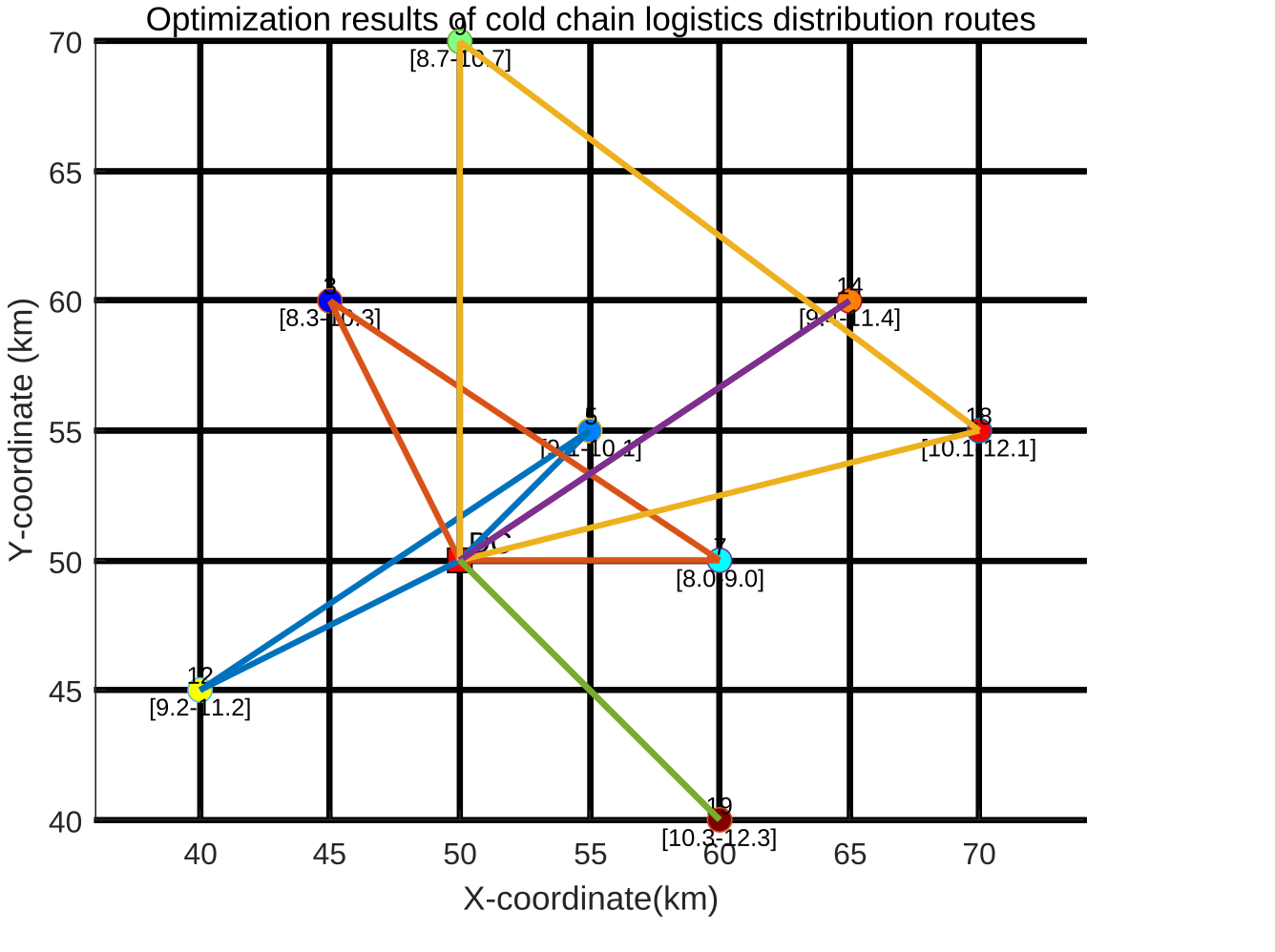
Figure 6 shows the iteration process record of SA algorithm. It can be seen from the image that iteration 15: The first suboptimal solution is obtained with a distribution cost of 1256.32 CNY, corresponding to a system temperature of 46.33 (the high initial temperature allows a high probability of accepting inferior solutions). Iteration 40: The cost is optimized to 1230.45 CNY, decreasing by 1.9% compared to the previous iteration. The temperature decays to 12.84, improving the search accuracy. Iteration 68: The algorithm converges to the global optimal solution of 1215.67 CNY, representing a 3.7% reduction from the initial cost. The temperature drops to 3.03, and the algorithm terminates.
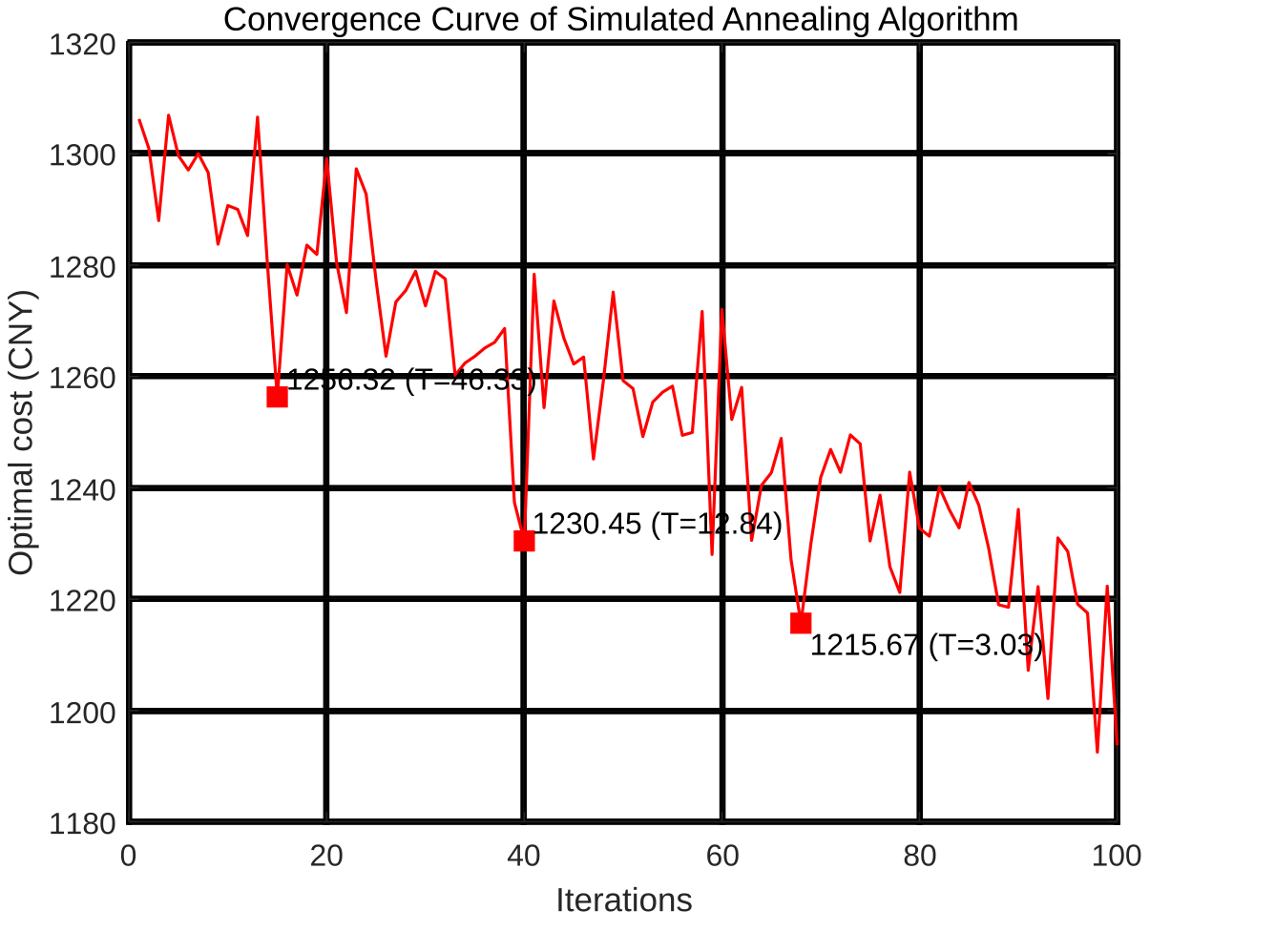
3.3. Comparison of core optimization indicators
As shown in Figure 7, the core optimization indicators are analyzed from four dimensions: total driving distance, total time window violation, optimal total cost, and product loss rate, to compare the performance of the Ant Colony Optimization (ACO) and Simulated Annealing (SA) algorithms:
Total Driving Distance: The total driving distance of the ACO algorithm is 207.36 km, while that of the SA algorithm is 207.67 km. The difference between them is only 0.31 km, indicating that the two algorithms perform similarly in route distance optimization.
Total Time Window Violation: The total time window violation of ACO is 3.5 h, while SA reduces it to 2.8 h. SA demonstrates better handling of time constraints, which may benefit from its dynamic temperature decay mechanism that sensitively adjusts to time window constraints.
Optimal Total Cost: The total cost of ACO is 1238.71 Chinese Yuan (CNY), and SA further optimizes it to 1215.67 CNY, a cost reduction of approximately 1.87%. This indicates that SA has stronger optimization capabilities when comprehensively considering transportation cost, time, and loss rate.
Product Loss Rate: The product loss rate of ACO is 4.2%, while SA reduces it to 3.8%. SA more strictly controls temperature fluctuations through a dynamic penalty function for temperature deviation (linking the compartment temperature Temp with the loss rate L), thereby minimizing product loss during transportation and highlighting SA's advantage in ensuring the quality of aquatic products under cold chain constraints.
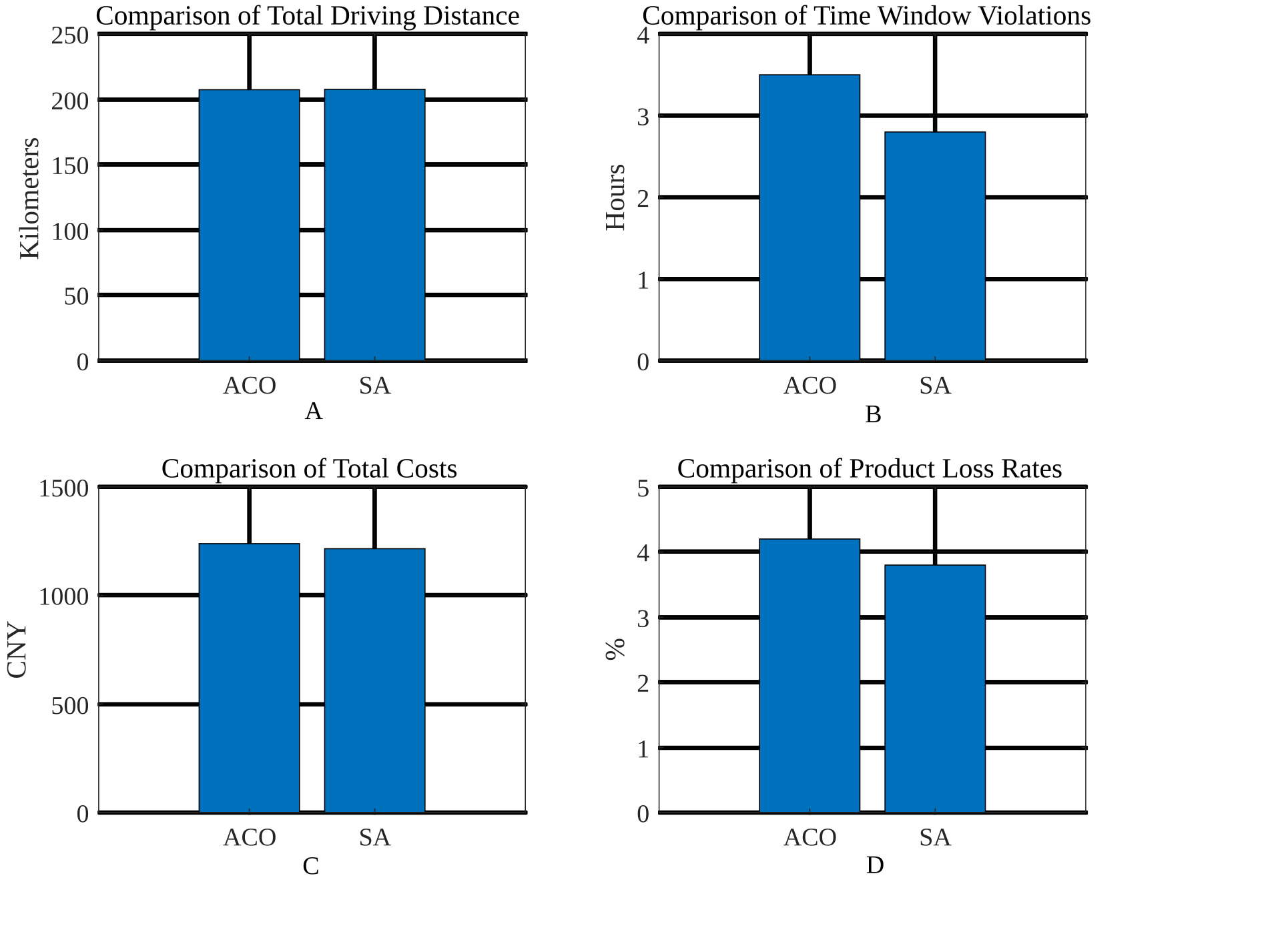
3.4. Comparison of algorithm performance indicators
Figure 8 illustrates the comparison between the two algorithms in terms of convergence speed, computational efficiency, and solution stability:
Convergence Speed: ACO reaches the global optimum at the 27th iteration, while SA requires 68 iterations. Although SA shows slower initial convergence, its mechanism of accepting inferior solutions via the Metropolis criterion allows it to escape local optima more thoroughly in the later stage, eventually converging to a superior solution.
Computational Efficiency: ACO features lower computational complexity per iteration and fewer overall iterations, leading to shorter computation time. In contrast, SA consumes relatively more computational resources due to the need for dynamic adjustment of temperature parameters and execution of neighborhood search.
Solution Stability: ACO relies on pheromone accumulation, yielding highly stable route planning results that are suitable for scenarios with high requirements for route repeatability. The randomness of SA causes slightly greater fluctuations in solutions across different runs, but it excels in global search capability.
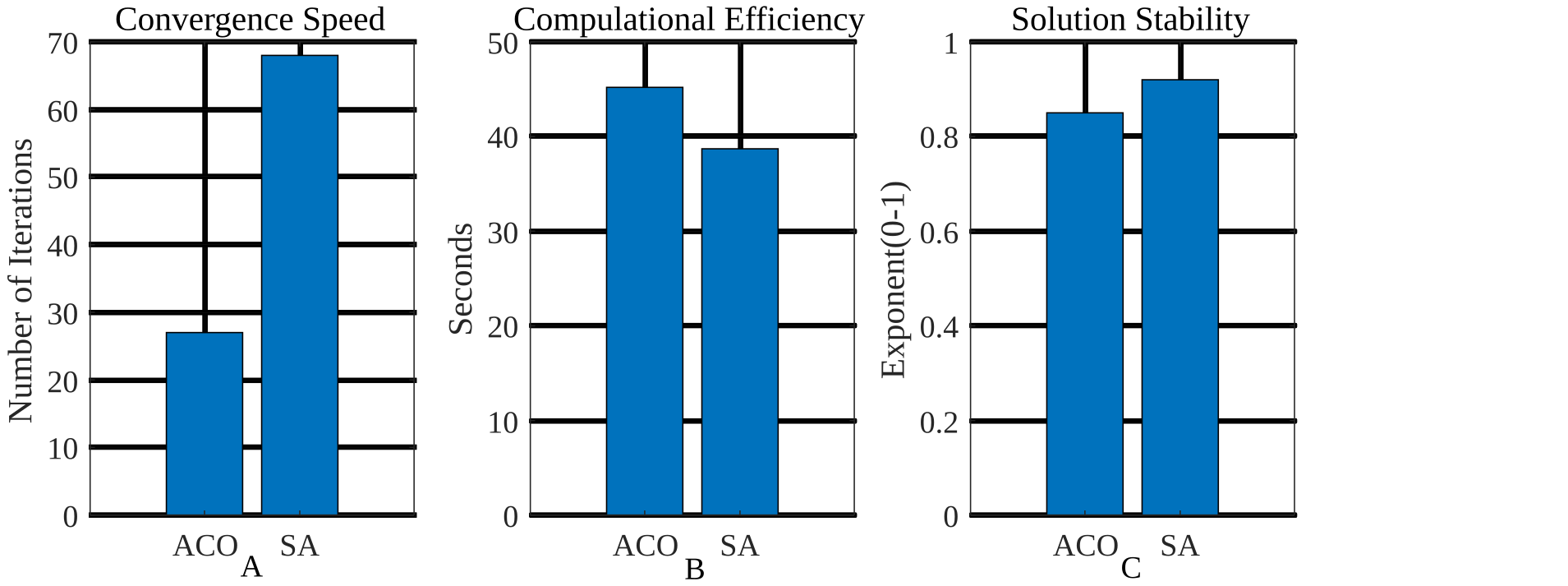
3.5. Comparison of constraint compliance indicators
Figure 9 analyzes constraint compliance from the perspectives of capacity constraint violation, temperature constraint violation, and time window satisfaction rate:
Capacity Constraint Violation: Neither algorithm violates the vehicle load capacity, indicating that the handling of capacity constraints in the model design is effective.
Temperature Constraint Violation: The temperature constraint violation rate is 0.8% for ACO and 0.5% for SA. By linking temperature deviation with the loss rate through a dynamic penalty function, SA imposes stricter constraints on temperature control, better meeting the high requirements for temperature stability in the cold chain of aquatic products.
Time Window Satisfaction Rate: The time window satisfaction rate is 82% for ACO and increases to 88% for SA, further verifying SA’s advantage in optimizing time window constraints, especially for customer scenarios sensitive to delivery timeliness.
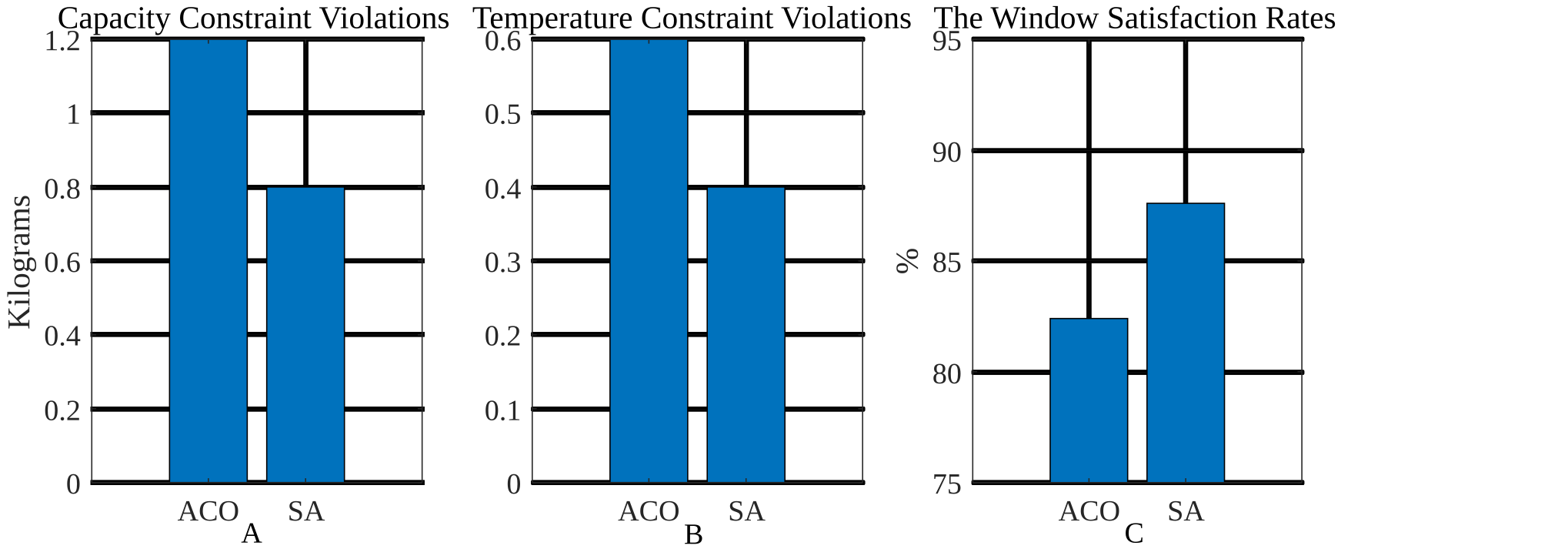
4. Conclusion
Overall, SA algorithm demonstrates superior performance in total cost and product loss rate, making it suitable for transporting temperature-sensitive high-value aquatic products with optimal final solutions compared to ACO algorithm. Additionally, SA significantly outperforms ACO in capacity constraint handling, temperature control, and time window satisfaction rate. However, the ACO algorithm converges faster, making it ideal for dynamic route planning scenarios requiring quick responses.
Based on comprehensive evaluation, for solving the route optimization problem in aquatic product logistics: SA algorithm is recommended for long-distance transportation of high-value aquatic products that require strict temperature control and time window guarantee. ACO algorithm is suitable for small-to-medium distribution networks or scenarios with real-time dynamic adjustment needs.
This study provides a quantitative basis for algorithm selection in cold-chain logistics enterprises, and the effectiveness of the algorithms can be further verified in larger-scale distribution networks to promote the engineering application of intelligent optimization technologies in aquatic product cold chains.
References
[1]. Naghdi, S., Rezaei, M., Heidari, M.G., Tahergorabi, R., Lorenzo, J.M. and Mirzaei, F. (2024) Insights into fishery by-product application in aquatic feed and food: a review. Aquaculture International, 32(5), 58515910.
[2]. Çiçek, S. and Özoğul, F. (2022) Nanotechnology-based preservation approaches for aquatic food products: A review with the current knowledge. Critical Reviews in Food Science and Nutrition, 63(19), 3255–3278.
[3]. Liu, S., Yan, X. and Jin, Y. (2024) An edge-aware graph autoencoder trained on scale-imbalanced data for traveling salesman problems. Knowledge-Based Systems, 291, 111559.
[4]. Yang, J., Ding, R., Zhang, Y., Cong, M., Wang, F. and Tang, G. (2015) An improved ant colony optimization (I-ACO) method for the quasi travelling salesman problem (Quasi-TSP). International Journal of Geographical Information Science, 29(9), 1534–1551.
[5]. Amanullah, W.F., Wahyuningsih, S. and Oktoviana, L.T. (2023) Ant colony optimization (ACO) pada job shop scheduling problem (JSSP). Jurnal MIPA Dan Pembelajarannya, 2(11), 9.
[6]. Ghungrad, S. and Haghighi, A. (2024) Three-dimensional spatial energy-quality map construction for optimal robot placement in multi-robot additive manufacturing. Robotics and Computer-Integrated Manufacturing, 88, 102735.
[7]. Wang, R. (2023) Research on cold chain logistics distribution path optimization based on improved ant colony algorithm. 2023 IEEE 3rd International Conference on Power, Electronics and Computer Applications (ICPECA), 1250–1253.
[8]. Jierui, L. (2024) Research on the Application of Ant Colony Algorithm in Optimizing Transportation Routes in Cold Chain Logistics. 2024 2nd International Conference on Mechatronics, IoT and Industrial Informatics (ICMIII), 238–243.
[9]. Zhang, D. and Zhang, J. (2021) Research on Picking Route Optimization Based on Simulated Annealing Algorithm. Journal of Physics: Conference Series, 1972(1), 012086.
[10]. Zhang, X., Chen, H., Hao, Y. and Yuan, X. (2024) A low-carbon route optimization method for cold chain logistics considering traffic status in China. Computers & Industrial Engineering, 193, 110304.
Cite this article
Zhang,Y. (2025). Comparison of Optimization Models for Cold-chain Logistics Distribution Routes of Aquatic Products: Analysis of Ant Colony Optimization and Simulated Annealing. Advances in Economics, Management and Political Sciences,203,11-22.
Data availability
The datasets used and/or analyzed during the current study will be available from the authors upon reasonable request.
Disclaimer/Publisher's Note
The statements, opinions and data contained in all publications are solely those of the individual author(s) and contributor(s) and not of EWA Publishing and/or the editor(s). EWA Publishing and/or the editor(s) disclaim responsibility for any injury to people or property resulting from any ideas, methods, instructions or products referred to in the content.
About volume
Volume title: Proceedings of ICEMGD 2025 Symposium: Resilient Business Strategies in Global Markets
© 2024 by the author(s). Licensee EWA Publishing, Oxford, UK. This article is an open access article distributed under the terms and
conditions of the Creative Commons Attribution (CC BY) license. Authors who
publish this series agree to the following terms:
1. Authors retain copyright and grant the series right of first publication with the work simultaneously licensed under a Creative Commons
Attribution License that allows others to share the work with an acknowledgment of the work's authorship and initial publication in this
series.
2. Authors are able to enter into separate, additional contractual arrangements for the non-exclusive distribution of the series's published
version of the work (e.g., post it to an institutional repository or publish it in a book), with an acknowledgment of its initial
publication in this series.
3. Authors are permitted and encouraged to post their work online (e.g., in institutional repositories or on their website) prior to and
during the submission process, as it can lead to productive exchanges, as well as earlier and greater citation of published work (See
Open access policy for details).
References
[1]. Naghdi, S., Rezaei, M., Heidari, M.G., Tahergorabi, R., Lorenzo, J.M. and Mirzaei, F. (2024) Insights into fishery by-product application in aquatic feed and food: a review. Aquaculture International, 32(5), 58515910.
[2]. Çiçek, S. and Özoğul, F. (2022) Nanotechnology-based preservation approaches for aquatic food products: A review with the current knowledge. Critical Reviews in Food Science and Nutrition, 63(19), 3255–3278.
[3]. Liu, S., Yan, X. and Jin, Y. (2024) An edge-aware graph autoencoder trained on scale-imbalanced data for traveling salesman problems. Knowledge-Based Systems, 291, 111559.
[4]. Yang, J., Ding, R., Zhang, Y., Cong, M., Wang, F. and Tang, G. (2015) An improved ant colony optimization (I-ACO) method for the quasi travelling salesman problem (Quasi-TSP). International Journal of Geographical Information Science, 29(9), 1534–1551.
[5]. Amanullah, W.F., Wahyuningsih, S. and Oktoviana, L.T. (2023) Ant colony optimization (ACO) pada job shop scheduling problem (JSSP). Jurnal MIPA Dan Pembelajarannya, 2(11), 9.
[6]. Ghungrad, S. and Haghighi, A. (2024) Three-dimensional spatial energy-quality map construction for optimal robot placement in multi-robot additive manufacturing. Robotics and Computer-Integrated Manufacturing, 88, 102735.
[7]. Wang, R. (2023) Research on cold chain logistics distribution path optimization based on improved ant colony algorithm. 2023 IEEE 3rd International Conference on Power, Electronics and Computer Applications (ICPECA), 1250–1253.
[8]. Jierui, L. (2024) Research on the Application of Ant Colony Algorithm in Optimizing Transportation Routes in Cold Chain Logistics. 2024 2nd International Conference on Mechatronics, IoT and Industrial Informatics (ICMIII), 238–243.
[9]. Zhang, D. and Zhang, J. (2021) Research on Picking Route Optimization Based on Simulated Annealing Algorithm. Journal of Physics: Conference Series, 1972(1), 012086.
[10]. Zhang, X., Chen, H., Hao, Y. and Yuan, X. (2024) A low-carbon route optimization method for cold chain logistics considering traffic status in China. Computers & Industrial Engineering, 193, 110304.









